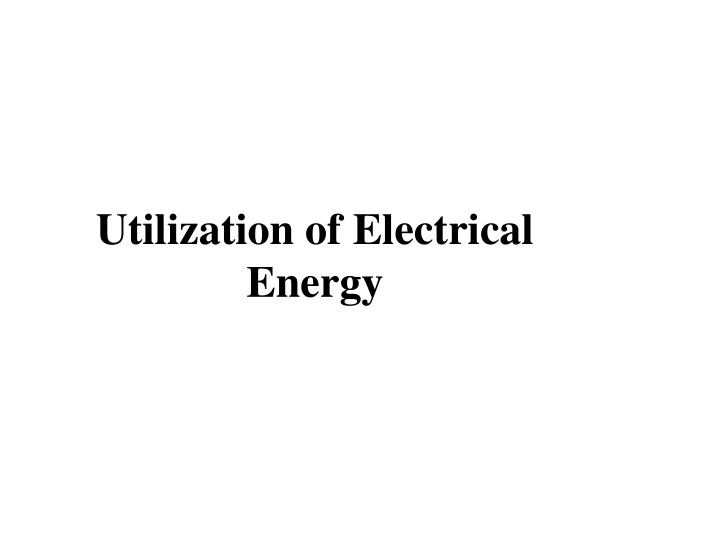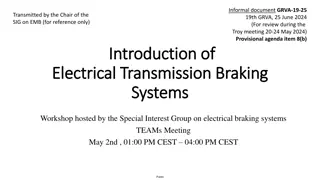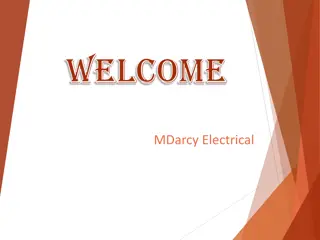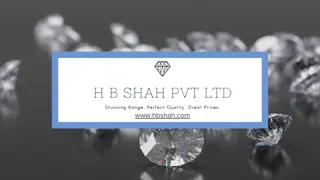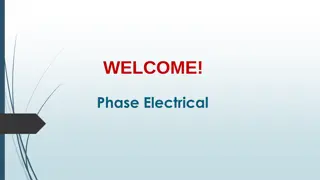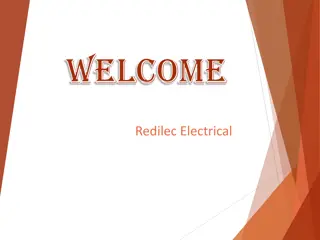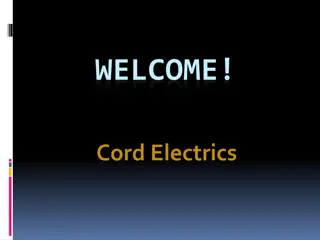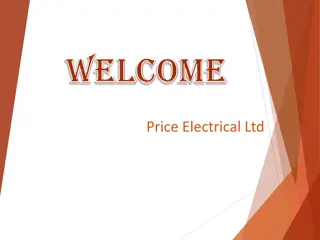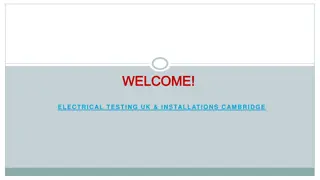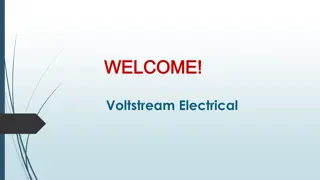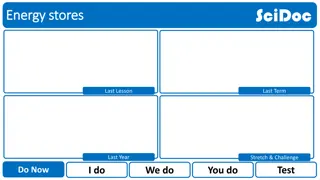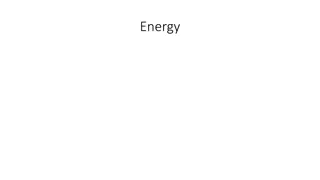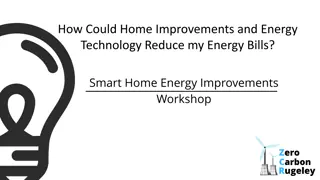Utilization of Electrical Energy in Industrial Applications
Electrical energy is widely utilized in various industrial applications, including driving loads with electric motors, electric heating, and welding operations in manufacturing processes. Electric drives offer advantages like low maintenance cost, high efficiency, and easy speed control. Factors to consider when selecting a drive include electrical, mechanical, and economical aspects. Despite its benefits, electric drives have disadvantages such as dependency on electric supply availability. Understanding these factors is crucial in optimizing the use of electrical energy in industrial settings.
Download Presentation

Please find below an Image/Link to download the presentation.
The content on the website is provided AS IS for your information and personal use only. It may not be sold, licensed, or shared on other websites without obtaining consent from the author.If you encounter any issues during the download, it is possible that the publisher has removed the file from their server.
You are allowed to download the files provided on this website for personal or commercial use, subject to the condition that they are used lawfully. All files are the property of their respective owners.
The content on the website is provided AS IS for your information and personal use only. It may not be sold, licensed, or shared on other websites without obtaining consent from the author.
E N D
Presentation Transcript
Utilization of Electrical Energy
Course outcome C403.5: Explain various types of electric heating and Welding Operations in manufacturing processes.
INDUSTRIAL APPLICATIONS
Introduction Electrical energy is utilized in many forms. Driving load by electric motor is one such application. Electric drives are quick to start, have high efficiency and the speed can be easily controlled. Different motors have different characteristics and depending upon load characteristics, the motor with suitable characteristics can be chosen for a particular applications. Hence electric drives are widely preferred over other types of mechanical drives. But while selecting a motor for a particular drive many factors are required to be considered. All the desired properties are never available in one type of motor. But the motor which fulfills majority requirements should be selected.
Advantages of electric drives: 1. Low maintenance cost. 2. Low power loss. 3. Easy and smooth speed control. 4. Simple construction. 5. High efficiency. 6. Operating is clean. 7. High quality for the finished product. 8. It needs less space. 9. Long life.
Disadvantages: 1. It can not be used at places where electric supply is not available. 2. The electric drive system stops as soon as there is a failure of electric supply.
Factors to be considered while selecting a drive These factors can be divided into three types: 1. Electrical aspects 2. Mechanical aspects 3. Economical aspects Electrical aspects: 1. Nature of supply: Supply available cab be dc or ac. Again in ac supply, it can be single phase or three phase supply. 2. Speed control: It must be possible to raise the speed below and above rated value. 3. Power factor: The motor must be able to operate at high power factor closer to unity value. 4. Efficiency: efficiency of motor should be high.
Mechanical aspects: 1. Type of enclosure: Whether enclosure of machine should partially closed to cover the rotating parts only or completely covered. 2. Types of bearing: The types of bearing depends upon speed. 3. Noise level: The noise produced due to rotation of motor should be minimum. Economical aspects: 1. Capital cost: The price to be paid for purchasing motor and interest and depreciation on its price over its life is main deciding factor. 2. Running charges: These will vary according to demand for power. 3. Maintenance charges: Frequent maintenance may increase total expenditure.
Classification Of Electric Drives Electric drives are basically classified into three categories as: 1. Individual drives: If each machine has its individual driving motor then the drive is known as individual drive. 2. Group drives: In the group drive, one motor is used to drive many machines. It is also known as line shaft drive. 3. Multimotor drives: In a multimotor drive different parts of driving mechanisms are actuated by using separate motors.
Selection Of Motors For Different Drives The selection of driving motor mainly depends on the following factors: 1. Electrical characteristics 2. Mechanical characteristics 3. Size and ratings of motors 4. Cost Electrical characteristics: Following electrical characteristics of motor to be considered. 1. Starting characteristics of a motor 2. Running characteristics of a motor 3. Techniques for speed control 4. Techniques for braking
Mechanical characteristics: Following mechanical characteristics of motor to be considered. 1. Types of enclosure 2. Types of bearings 3. How transmission of power would take place. 4. Cooling types 5. Acceptable level of noise. Size and rating of motors: This depend on following parameters: 1. Types of load cycle 2. Overload capacity of a motor for an applications.
Cost: There are two types of costs involved: 1. Capital costs 2. Running costs Other factors: 1. Types of available supply: AC or DC. 2. Matching the mechanical output of the motor with the load requirement.
Different Enclosures The type of enclosure for a motor is to be decided based on the applications, type of work the motor is supposed to perform and place where it is installed. Various types of commonly used enclosures are as follows: 1. Open type 2. Protected type 3. Drip proof type 4. Splash proof type 5. Totally enclosed 6. Pipe ventilated 7. Frame proof
Open type enclosure: In this type of enclosure, the machine is open from both ends. This allows free ventilation. Protected type enclosure: In this type, the machine is not completely open from both ends, instead some openings are provided for ventilation with enhanced protection. The advantage of this type of enclosure is that without degrading the ventilation, the protection is enhanced. Drip proof enclosure: this type of enclosure does not allow the liquids or moisture to reach the motors.
Splash proof type: These enclosures are designed in such a away that liquid or dust particles at an angle between vertical and 1000 will not able to enter the machine. Totally enclosed type: This type of enclosure does not allow any foreign particles to enter into the motor and block the passage of ventilation. Pipe ventilated type: In this type the pipes are used for providing ventilation. Flame proof enclosure: This is a special type of enclosure which is used when the motor is to be used in the explosive atmosphere.
Electric Heating And Welding
Introduction Electric heating is used for industrial as well as domestic applications. Some of them are as follows: Domestic applications: 1. Electric irons 5. Hot plates for cooking 2. Electric kettles 6. Water heaters 3. Electric ovens 7. Room heaters 4. toasters
Industrial applications: 1. Heat treatment of insulators 2. Copper wires enamelling 3. For heat treatment of metals 4. To melt various metals 5. Glass moulding
Advantages of electric heating: 1. Electrical heating processes are clean due to absence of smokes, ash, dust etc. 2. As fuel gases are absent in the heating processes, there is no risk of any pollution. 3. Electrical heating equipment is more safe as electrical tripping devices act reliably and instantaneously upon abnormal conditions. 4. Electrical heaters usually require very little attention and maintenance. 5. Very high temperatures can be obtained. 6. Time required to attain these temperatures is less. 7. Fuel need not be stored. 8. Energy spent can be metered and measured.
Types of Electrical Heating The classification of electric heating:
Resistance Heating In this method, when a resistance R carries a current I for t seconds, I2Rt is the heat produced. This heat is used for heating purpose. There are two types of resistance heating, direct and indirect heating. 1. Direct resistance heating: Usually, the body to be heated is called a charge. In this process, the electric current is passed through the charge itself. As the heat is developed in the charge itself, this becomes a very efficient process of heating. ex. Water heater
2. Indirect resistance heating: In this method, heat is transferred to the charge by conduction, convection or radiation. Applications: 1. Water geyser 2. Cooking oven 3. Furnaces 4. Room heaters 5. Heat treatment of metals 6. Pottery work
Induction heating According to Faraday s law, when a magnetic flux links with a conducting body, EMF is induced in the body and thus current flows in it. This principle is used for the purpose of heating bodies which have sufficiently low resistivity. Square of the current induced multiplied by body resistance is the power utilized in heating the body. Therefore, this type of heating can be used for the bodies which are conducting in nature.
Eddy Current Heating By heating an article by eddy currents, it is placed in-side a high frequency a.c. current-carrying coil. The alternating magnetic field produced by the coil sets up eddy currents in the article which, consequently, gets heated up. Such a coil is known as heater. coil or work coil & the material to be heated is known as charge or load. Primarily, It is the eddy current loss which is responsible for the production of heat although hysteresis loss also contributes to some extent in the case of non magnetic material. The eddy current loss We b2 f2. Hence, this loss can be controlled by controlling flux density B and the supply frequency f. This loss is greatest on surface of the material but decreases as we go deep inside.
Applications: 1. Surface hardening of metals. 2. Annealing of metals. 3. Brazing. 4. Soldering. 5. Induction cooking.
Dielectric heating In dielectric heating, a high frequency, high ac voltage is applied across a dielectric material. The dielectric work piece is held between two metal electrodes. The dielectric material can be plastic, wood etc. Due to high voltage RF excitation, some current flows through dielectric material and due to this flow some loss takes place in the dielectric which is called as dielectric loss. This power loss takes place in the form of heat and the dielectric material gets heated up due to it. This is the principle of dielectric heating.
Applications: 1. Gluing, curing and drying of wood. 2. Preheating plastic perform of condition them for moulding. 3. Plastic sewing. 4. Drying and heat treatment of natural and synthetic rubber, rayon, nylon etc. 5. Processing of chemicals during manufacture.
Electric Welding Welding is the process of joining two pieces of metal or non metal by applying heat or/and pressure. Classification: All the welding processes are classified as 1. Fusion welding 2. Non-fusion welding
1. Fusion welding: This type of welding takes place by melting the two metals to be welded together. Examples of fusion welding: i. Gas welding ii. Electron beam welding iii. Electrogas welding iv. Carbon arc welding
2. Non-fusion welding: In this type of welding the metals to be welded together need not be melted. Examples o0f non fusion welding are as follows: 1. Resistance welding 2. Gas non fusion welding 3. Ultrasound welding 4. Friction welding
Arc welding The electrodes used for this welding are made up of carbon or graphite. An electric arc is struck when the short-ciruited electrodes are separated a little bit. In the process of withdrawing the electrodes apart, the area of contact of electrodes first reduces which increases the resistance producing large localized heat and then on actual separation of electrodes, arc is struck. Due to high temperature of arc, electrode melts and weld is produced.
Classification of arc welding: 1. Metal arc welding 2. Carbon arc welding 3. Atomic hydrogen welding
1. Metal arc welding: In this type, the welding electrode itself is made up of the filler metal. At the time of welding the current flows through the welding electrode, arc, work piece to earth. It is possible to use ac or dc supply.
2. Carbon arc welding: The electrodes used in this system are of carbon or graphite. The supply voltage should be dc. The work piece to be welded is connected to positive end of the supply and the carbon electrode is connected to the negative end. Huge current of the order of 800 to 1000 A are drawn from the dc supply at the time of welding.
3. Atomic hydrogen welding: In this method, the tungsten electrodes are kept in the hydrogen atmosphere. The arcing takes place between the two tungsten electrodes. Hydrogen acts as an agent which atomises and maintains the arc between the electrodes independent of the work pieces to be welded. The hydrogen acts in two fold manner, as a cooling agent as well as a protective screen.
Electrometallurgical & Electro Agro Systems
Effects Of Electric Current There are various types of effects of electric current as follows: 1. The magnetic effects 2. The chemical effects 3. The heating effects
The Chemical Effects of Electric Current Whenever a dc current is passed through a chemical solution, the solution is decomposed into its constituent substances. This process is called as the chemical effect of the electric current. The chemical effect of current is used in the following applications: 1. For extracting metals from their ores. 2. For electrodeposition of metals.(electroplating) 3. For refining of metals etc. The electrodeposition process of metals is used for electroplating and electrotyping.
Electrolytes: Electrolytes are the liquids which allow the electric current to pass through them. Such a current flow results is some chemical changes in the electrolyte. Ionization: Ionization is the process in which the molecules are split into positive and negative ions.
Electrolysis Fig.(1) shows the process of electrolysis. The electrolyte is prepared by mixing the copper sulphate in water. Then, the molecules of CuSO4 are dissociated into positive copper (Cu) ions and negative sulphate (SO4) ions. These ions start moving in the electrolyte. If two electrodes with an external battery connected between them as shown in fig.(1) dipped into electrolyte, Cu ions attracted towards negative electrode and SO4 ions attracts towards positive electrode.
The sulphate ions then react with water to form sulphuric acid and oxygen is liberated at the positive electrode. 2 SO4 + 2 H2O = 2 H2SO4 + O2 Thus due to the passage of dc current, the electrolyte will get decomposed. This process is called as electrolysis.
Applications of electrolysis: 1. For electrodeposition of metals (electroplating) 2. For refining of metals. 3. For extracting metals from their ores.
Electroplating Electroplating is the process of depositing a layer of some material for protective purposes on the articles of other base metals. Fig.(1) shows the electroplating process. Electrolyte is kept is tank which is made up of chemically resistant material like RCC, wood, fibre glass etc. In electrolyte anode and the article to be plated is dipped. The anode is connected to positive terminal of battery and article to be plated is connected negative terminal of battery. As soon as external dc supply is turned on, the process of electrolysis will begin. The anode is made up of metal to be deposited. So it loses the metal and layer of that metal gets depositied on the article and the article to be electroplated.
Applications of electroplating: 1. Gold or silver plating on ornaments 2. Zink, nickel or chromium plating on the cast iron and steel iron parts to prevent corrosion. 3. Surface are plated with nickel or chromium for extra shining.
